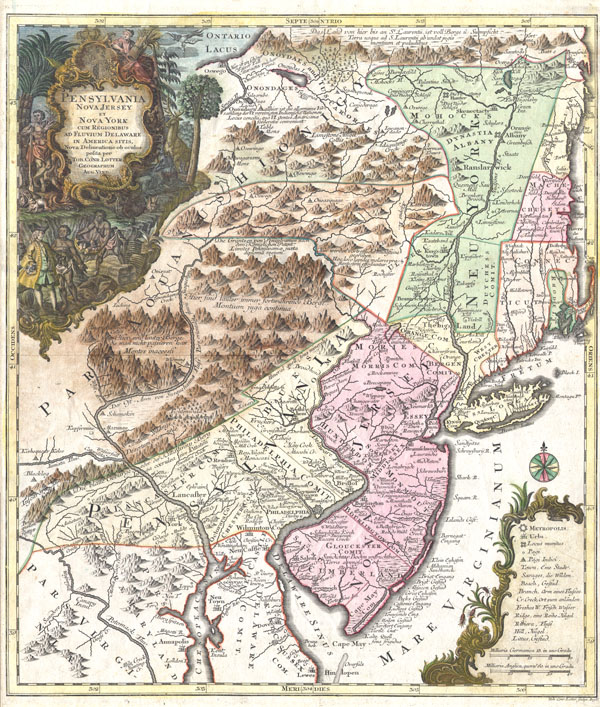This item has been sold, but you can get on the Waitlist to be notified if another example becomes available, or purchase a digital scan.
1756 Lotter Map of Pennsylvania, New Jersey & New York
PensylvaniaNovaJersey-lotter-1756
Title
1756 (undated) 22.5 x 19.5 in (57.15 x 49.53 cm)
Description
The original Evans map was intended as a map of the British colonies of New York, New Jersey, and Pennsylvania. Pennsylvania is shown bounded by the Appellations in accordance with the land purchases William Penn made from the Iroquois League. New York in divided into three parts comprising of what is today New York and Vermont. Manhattan is shown attached to the mainland and Brooklyn appears as 'Brockland.'
On a more furtive level, Evans' maps was also a spy map of the Indian territories west of the Appalachian Mountains. As the inhabited parts of Pennsylvania and New York slowly stretched westward into Indian lands, the governing bodies became increasingly aware of the need for accurate reconnaissance of the region. Evans was one of the first cartographers to penetrate and offer a reasonably accurate map of these areas. The map offers good reference to previously unmapped Indian villages, tribal regions, forts, and river ways.
The portions of Lotter's map that were drawn directly from the Evans map are therefore surprisingly accurate. In a departure from the Evans, map, however, Lotter also decided to include within the boundaries of his map the coast of New England and the colonies of Rhode Island, Connecticut, and New Hampshire. These areas appear as if they were added as an afterthought and are consequently wildly, almost humorously, inaccurate. Indeed, it almost seems as if New England was molded to fit the map plate rather than the map made to fit New England. Boston and Cape Cod are drawn well within the boundaries of Connecticut. The western border of New Hampshire is entirely made of up the Atlantic seaboard. Rhode Island just obscenely into Connecticut which itself in distended along the vertical. All four of the New England colonies shown are also miniaturized along the horizontal.
The decorative title cartouche in the upper left quadrant depicts William Penn surrounded by the flora and fauna of the region - turkeys, deer, rabbits, etc…, purchasing land from the indigenous American Indian tribes.
Many issues of this map have a very weak impression due to overuse of the original plate. This particular map on the other hand has a fine dark impression and is consequently a rare find.
Cartographer
Tobias Conrad Lotter (1717 - 1777) was a German engraver and map publisher. Lotter was the son of a baker and city guardsman, but married Euphrosina (1709 - 1784) Seutter, elder daughter of the prominent map publisher Matthäus Seutter. He began working at his is father-in-law's map business about 1740. Between 1740 and 1744 he produced, under Seutter's imprint, the Atlas minor, Praecipua orbis terrarum imperia, regna et provincias, Germania potissimum tabelli. Upon Seutter's death, in 1757, the firm's stock was taken over by his son, Albrecht Karl Seutter (1722 - 1762), who himself died in 1762, just a few years later. The remaining Seutter map plates were subsequently divided between Lotter and the publisher Johan Mitchell Probst (1727 - 1776). With the support of his sons, Matthäus Albrecht (1741 - 1810), Georg Friedrich (1744 - 1801) and Gustav Conrad (1746-1776), Tobias Conrad Lotter succeeded in building on the economic success and professional reputation of his father-in-law. In time, Lotter became one of the most prominent mid-18th century map publishers working in the German school. After Lotter's death in 1777, the business was taken over by his two eldest sons, who, lacking their father's business acumen, presided over the firm's slow decline. It was nonetheless passed on to a subsequent generation of Lotters, Matthäus Albrecht Lotter's sons, Gabriel (1776 - 1857) and Georg Friedrich (1787 - 1864), who pushed it into further decline until it faded out in the early-19th century. More by this mapmaker...

